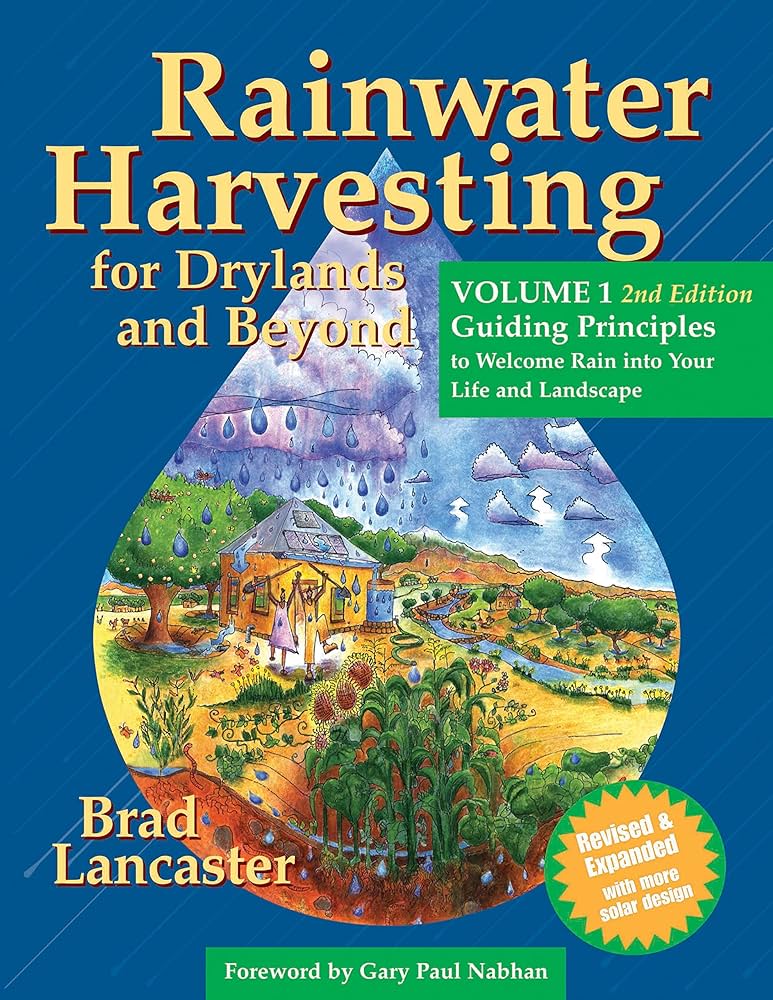Review by Pam Sherman

Brad Lancaster lives in a city which gets 11 inches of rain a year. Tucson AZ is one water-stressed city in the desert, getting its city water from the Colorado River 300 miles away. He writes: “we’d typically have more free local water than we need if we’d consciously harvest it, rather than wastefully drain it away. And we don’t need any fancy equipment or large infrastructure to do so.”
Before reading this book review, watch Brad on this video (6:25) on his website; it’s the best introduction to his work. Then watch the first video on this page, where he demonstrates why rainwater harvesting is a whole dimension change from setting out a few rainbarrels. They are a nice start, but not up to the task of capturing the rainfall and sinking it into the ground to re-wild the landscape. Then go here for the big picture of where our rain goes and how water harvesting can help the watershed. Now you’re set!
Lancaster’s life’s work has been to learn how to capture all the precious rain that falls in arid areas. He has learned from drought farmers in Africa, India, the Middle East, Europe and right here in the Southwest who practice age-old techniques for water capture and storage and have also designed new ways of using them.
The second part of his life work is to teach us what he has learned: how we can capture and store this living treasure in the soil at our homes and in our communities so our mostly native plantings can flourish and thus, so can we. Working together, we can restore water for native habitat and revitalize watersheds from mountains to plains, whether we live rural or urban.
Lancaster literally wrote the book on this topic; rather, a two-volume set. And his website, Harvesting Rainwater, is a wealth of further learning. Both books and website are clear and easy to read. Volume I “explains what water harvesting is, how to do it, and how to apply it to the unique conditions of your site. The aim is to realize the maximum effectiveness for the least effort and cost. This book will also help you convey water-harvesting ideas to the landscape designers,” crew, and volunteers who may be helping you.
He lays the foundation with an inspiring story of one of his teachers, “the man who farms rainwater,” then lists of eight Rainwater-Harvesting Principles and ethics, based on permaculture practices.
In Chapter 2 we learn how to assess our site’s water resources and estimate our site’s water needs, whether we have ⅛ of an acre or many. Chapter 3 provides the overview of water-harvesting earthworks with a sampling of strategies and techniques such as berms and sunken gardens, contour berms, swales, brush weirs, waffle gardens, grid gardens, gravel- and- rock-mulched fields, roof catchment, contour berms, terraces, french drains, infiltration basins, check dams, gabions, cisterns, tanks, greywater, permeable hardscape, shade, windbreaks, sunbreaks, vegetation and more. He gives recommendations for a home plan and shares a story of how other home-dwellers have been doing it.
Chapter 4 offers seven integrated design patterns to create a regenerative landscape (constantly improving the condition of the land in terms of water infiltration ability to support life), with real-life examples.
The Appendices are vital: #1 discusses patterns of water flow and the erosion it creates, with a potential water-harvesting response for each. Appendix 2, an article by Joel Glanzberg, is an overview of “Water Harvesting Traditions in the Desert Southwest.” Appendix 3 is water-harvesting calculations, twelve vital equations you might want, especially if you are a landscape designer. Appendix 4 is a short list of native plants for his area and instructions on how to estimate the annual water requirements for a native plant.
Continuing on the path of “turning scarcity into abundance,” Volume II elaborates on earthworks. Start and end your Lancaster learning with his website, Harvesting Rainwater, where you can find videos and articles illustrating the strategies in his books.
Lancaster is well known and sought after by water officials and landscape designers around the world. In 2008 he was invited to present to the Colorado state legislature on water harvesting (and he did). Last year he gave presentations in Boulder at the University of Colorado Conference on World Affairs and Cool Boulder. His schedule is tight, but we have all we need in his books and website to create the lush native landscapes we are seeking. And to transform our relationship with water.
